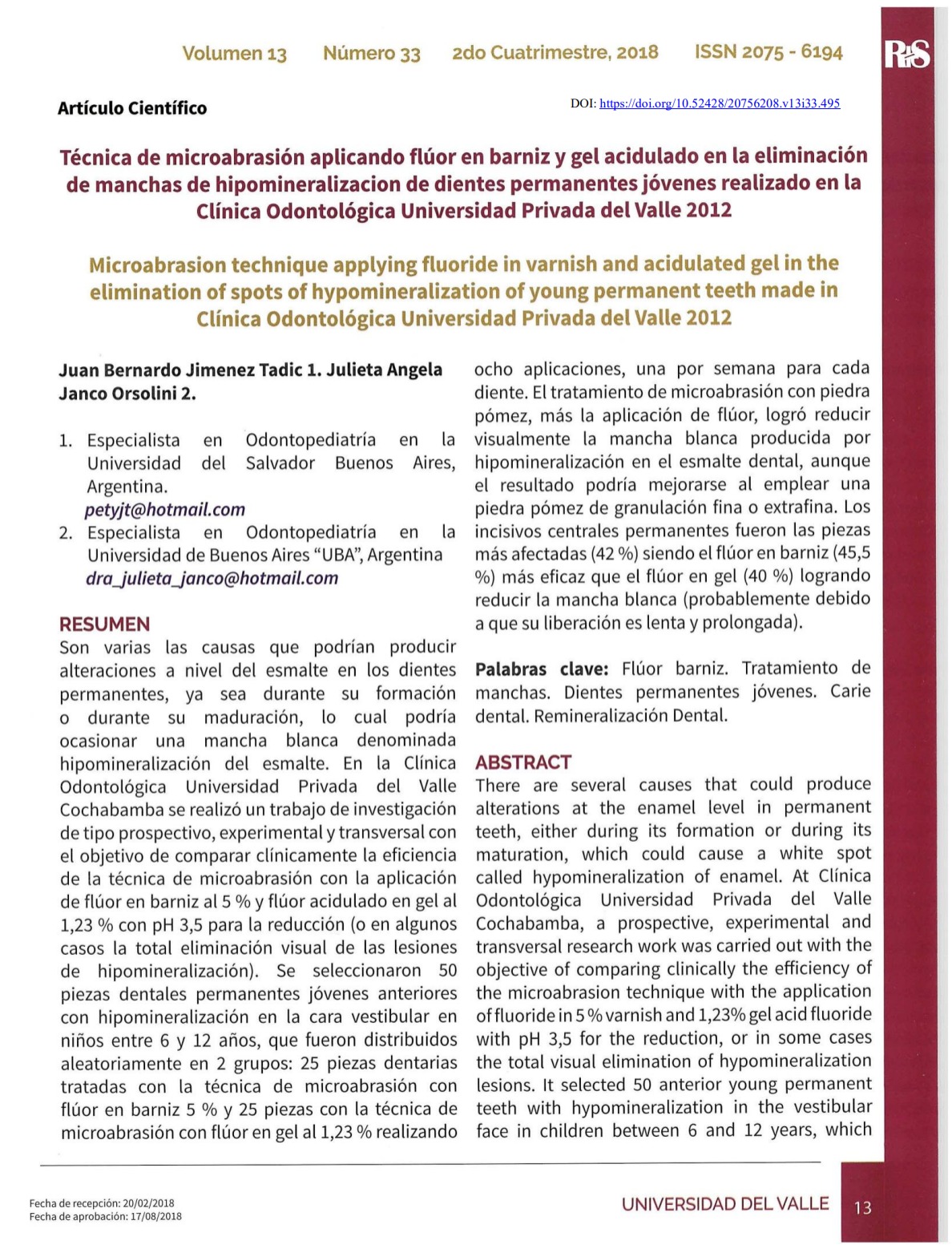Técnica de microabrasión aplicando flúor en barniz y gel acidulado en la eliminación de manchas de hipomineralizacion de dientes permanentes jóvenes realizado en la Clínica Odontológica Universidad Privada del Valle 2012
DOI:
https://doi.org/10.52428/20756208.v13i33.495Palabras clave:
Flúor barniz, Tratamiento de manchas, Dientes permanentes jóvenes, Carie dental, Remineralización DentalResumen
Son varias las causas que podrían producir alteraciones a nivel del esmalte en los dientes permanentes, ya sea durante su formación o durante su maduración, lo cual podría ocasionar una mancha blanca denominada hipomineralización del esmalte. En la Clínica Odontológica Universidad Privada del Valle Cochabamba se realizó un trabajo de investigación de tipo prospectivo, experimental y transversal con el objetivo de comparar clínicamente la eficiencia de la técnica de microabrasión con la aplicación de flúor en barniz al 5 % y flúor acidulado en gel al 1,23 % con pH 3,5 para la reducción (o en algunos casos la total eliminación visual de las lesiones de hipomineralización). Se seleccionaron 50 piezas dentales permanentes jóvenes anteriores con hipomineralización en la cara vestibular en niños entre 6 y 12 años, que fueron distribuidos aleatoriamente en 2 grupos: 25 piezas dentarias tratadas con la técnica de microabrasión con flúor en barniz 5 % y 25 piezas con la técnica de microabrasión con flúor en gel al 1,23 % realizando ocho aplicaciones, una por semana para cada diente. El tratamiento de microabrasión con piedra pómez, más la aplicación de flúor, logró reducir visualmente la mancha blanca producida por hipomineralización en el esmalte dental, aunque el resultado podría mejorarse al emplear una piedra pómez de granulación fina o extrafina. Los incisivos centrales permanentes fueron las piezas más afectadas (42 %) siendo el flúor en barniz (45,5 %) más eficaz que el flúor en gel (40 %) logrando reducir la mancha blanca (probablemente debido a que su liberación es lenta y prolongada).
Descargas
Citas
SALGADO Áo, PERALVO V, TORRES A, MATEOS MV, RIBAS D y CASTANO A. Prevalencia del síndrome de hipomineralización incisivo-molar: revisión de la literatura. Madrid: Revista Odontología pediátrica. 24(2): 134-148.
CABALLERO M. Una patología de origen desconocido "La hipomineralización incisivo-molar". España: Avantmêdic [Internet] 2014 [Consultado en abril de 2014] Disponible en:
CASTILLO R, FIGUEROA C, FLORES R, FUENTES P, GIRÓN V, PARAPAR N, PURCA T, QUIROZ K, RAVELO C, RODRÍGUEZ V y SÁNCHEZ J. Microabrasión del esmalte. Lima, Perú: Universidad Nacional Mayor de San Marcos [Internet] 2009 [Consultado en abril de 2012] Disponible en: http://sisbib.unmsm.edu.pe/bibvirtualdata/monografias/alumnos/alvarez pm.pdf
JANS A. y col, Frecuencia y severidad de la Hipomineralización Molar Incisal en pacientes atendidos en las clínicas odontológicas de la Universidad de La Frontera, Chile. Temuco, Chile: International Journal of Odontostomatology [Internet] 2011 [Consultado en abril de 2012] Disponible en:
http:/_/www.scielo.cl/scielo.php?script=sci arttext&pid=S0718-381X2011000200004
BONIFACIO M, MOREIRA C, SODRÉ F y DE ANDRADE MA. Tratamiento de hipoplasia del esmalte con la técnica de microabrasión en odontopediatría. República Dominicana: Rev. odontol. dominic. 1999; 5(1):9-14. [Internet] 1999 [Consultado en abril de 2012] Disponible en:
BOJ J. Odontopediatría La evolución del niño al adulto joven. Editorial Ripano, Madrid 2011.
AGUILAR D y PONCE C. Remineralización de lesiones cariosas activas incipientes después de la aplicación de un barniz fluorado, medida a través de un láser de diagnóstico. Perú: Odontol Pediatr. 2011;10(2): 95-104 [Internet] [Consultado en abril de 2012] Disponible en: http://docplayer.es/12958044-Remineralizacion-delesionescariosasactivasincipientesdesp uesde-la-aplicaciondeunbarnizfluorado-medid-a-travesdeunlaserde-diagnostico.html
NEVÁREZ M. Tratamiento para manchas por fluorosis dental por medio de micro abrasión sin instrumentos rotatorios. Colombia: Rev. CES Odont. 2010; 23(2)61-66 [Internet] [Consultado en abril de 2012] Disponible en: http://www.google. com.bo/url?sa=t&rct=j&q=&esrc=s&frm=1&source=web&cd=1&cad=rja&ved=0CCAQFjAA&url=http%3A%2F%2Fdialnet.unirio•a.es%2Fservlet%2Ffichero articulo%3Fcodi o%3D3581211&ei= Ow6ULvZK in6wHt1YH Bw&usg=AFQjCNEvgEWvrTkoWCPHVQ AHA
GUEDES A. Rehabilitación Bucal en Odontopediatría. Venezuela: Editorial Amolca; 2003.
BEZERRA DA SILVA L. Tratado de Odontopediatría. Venezuela: Editorial Amolca; 2008
PINKHAM J. Odontología Pediátrica. Barcelona: Editorial Mc Graw Hill; 2001

Descargas
Publicado
Cómo citar
Número
Sección
Licencia
Derechos de autor 2018 Juan Bernardo Jimenez Tadic y Julieta Angela Janco Orsolini

Esta obra está bajo una licencia internacional Creative Commons Atribución 4.0.
Los autores/as que publiquen en esta revista aceptan las siguientes condiciones:
- Los autores/as conservan los derechos de autor y ceden a la revista el derecho de la primera publicación, con el trabajo registrado con la licencia de atribución de Creative Commons 4.0, que permite a terceros utilizar lo publicado siempre que mencionen la autoría del trabajo y a la primera publicación en esta revista.
- Los autores/as pueden realizar otros acuerdos contractuales independientes y adicionales para la distribución no exclusiva de la versión del artículo publicado en esta revista (p. ej., incluirlo en un repositorio institucional o publicarlo en un libro) siempre que indiquen claramente que el trabajo se publicó por primera vez en esta revista.
- Se permite y recomienda a los autores/as a compartir su trabajo en línea (por ejemplo: en repositorios institucionales o páginas web personales) antes y durante el proceso de envío del manuscrito, ya que puede conducir a intercambios productivos, a una mayor y más rápida citación del trabajo publicado.






















